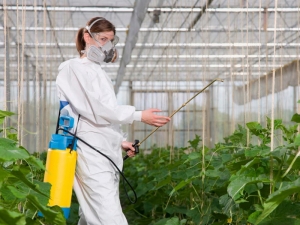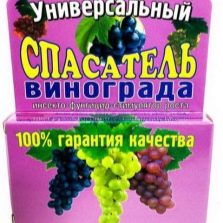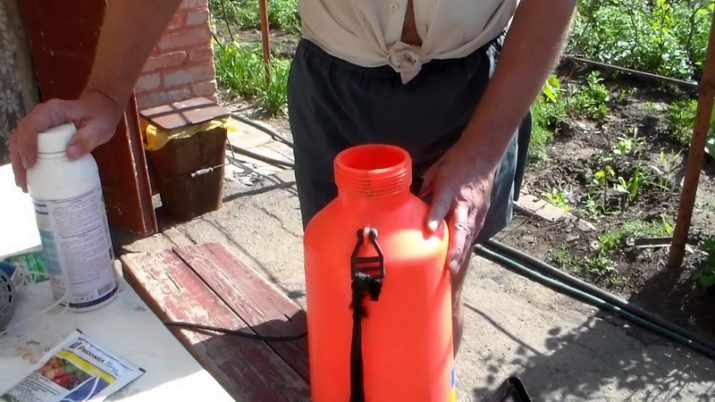Instructions for use of fungicides for grapes

Growing grapes is not easy, because he often suffers from fungal diseases. It is because of them that the quantity and quality of the harvested berries is reduced.To fight the fungus intended fungicides - drugs specifically designed by scientists. These chemical mixtures have a double effect: not only kill the causative agents of diseases, but also prevent the infection of plants - leaves and vines, thus preserving the harvest.
In the article we will try to figure out how to apply fungicides correctly, so as not to harm the grapes, while getting rid of the fungus. There will also be listed the most popular brands of fungicides with their brief characteristics.
Kinds
Grapes can be affected by spores of various fungal diseases: mildew, oidium, gray mold (as well as black and white), black spot. If you notice them in time, it is quite easy to cure the plant without losing the quality and quantity of fruits. In advanced cases, you can completely lose the crop and even grape bushes. In order to protect the plants or prevent their infection with fungus, fungicides are used. They can be organic or inorganic.
The name "fungicide" comes from two Latin words - "fungus", which means "mushroom", and "caedo" - it means "I kill." These compounds are precisely designed to destroy the spores of the fungus on plants, including the grape shoots. They are treated with bushes, shoots and leaves.
Fungicides are very popular with beginners and experienced growers, as they are very effective both for treating plants from fungus and for the prevention of this kind of disease. However, they have a relatively low cost and low consumption per 1 square meter. Another plus: you do not need to calculate the dosage, as it is described in detail on the packaging of the drug, in the instructions. Means are stored for a long time, so they can be used for two seasons.
Fungicides are of two kinds of action: local or systemic. The first plants do not penetrate into the plant cells, remaining on the surface. Local chemicals prevent fungus germination, spores die by contacting substances in the fungicide. As for the systemic drugs, they act in a complex manner - both on the surface of the bush and circulating through its cells. Accordingly, the treatment is the same: outside and inside.
According to the main property, fungicides can be divided into two large groups.
- Therapeutic. They can and should be used both before the disease - for prophylactic purposes, and after - to heal the plants.
- Protective. They need to spray the bushes of grapes with a certain frequency to prevent infection by fungus.
According to the principles of their action, herbicides are of different types.
Contact
They do not have the ability to penetrate into parts of the plant, remaining on the surface. Drugs do not protect against all types of fungus - only from those that have not yet sprouted, and prevent its further spread. It is important to take into account that contact fungicide is easy to wash off from the plant - rain or water when watering. Therefore, applying it, you need to ensure that the bush was covered completely, and after precipitation falls, update the coating. The inner surface of the leaves should also be covered with the composition.
Only in this way can high-quality protection of grapes against fungus. Such chemicals include Bordeaux liquid, "Omal", "Rowwright".
Systemic
These drugs differ from contact in that they are able to penetrate inside the plant. They circulate in the cells. It is systemic herbicides that help fight the disease from inside the plant. They should also be used regularly, with an equal period of time. They can not be washed off the plant either by rain or water. The optimal time for applying systemic fungicides is before and after flowering. But if the first signs of the fungus appeared earlier, then the grapes should be processed immediately. Systemic fungicides are "Kvadris", "Topaz", "Strobe."
Combined
As the name implies, these preparations combine the properties of systemic and contact preparations. The group includes such herbicides as "Shavit", "Cabrio Top".
The composition of fungicides are also different. Depending on the components, there are two groups.
- On the basis of copper it is, for example, “Azofos”, “Profit Gold”, “Ordan”. The drugs in this group have a universal effect, that is, they are effective against any fungal diseases.
- Azoles. The composition of these drugs include substances such as imidazole, penconazole and other similar substances. Azoles include "Coronet", "Tilt", "Skor", "Raek", "Topaz" and other analogues. The main diseases against which the azoles act are - powdery mildew, scab, rust, root rot.
Regardless of what type and brand of fungicide you have chosen to process the vineyard - contact or systemic, there must be regularity in its application. It is best to combine both species, then the plant protection from the fungus will be the strongest.
It is also necessary to alternate the drugs used, since the spores of the fungus tend to get used to the pesticides and remain resistant to them.
During the flowering of vines, it is strictly prohibited to spray them with a fungicide.
Popular drugs
When choosing a fungicide with which you plan to cultivate your vineyard, you should be guided by the reviews of not only experienced gardeners, but also scientists - biologists and breeders involved in the cultivation of new grapes and the care of them. In this section we will focus on the most popular and effective drugs.
To rid the bushes of grapes from such misfortunes as powdery mildew, scab, black spotting, Ikarus and Topaz chemicals will do. These drugs will help grapes grow.
Against mildew apply "Polyhom". This is a moderate toxic drug with an unlimited shelf life. One square meter of vineyard consumes up to 800 ml of solution. “Mikal” is not less effective not only in the fight against mildew, but also with oidium, black rot.
Such an organic fungicide as "Poliram" is used only for the prevention of fungal diseases. In due time processed bushes do not infect such diseases as scab, rust, mildew. Its granules are dissolved in water. However, there is a downside to toxic chemicals: it is produced only in ten-kilogram bags, which is not very convenient if you have a small vineyard. In addition, to cure already ill plants will not work. Another “Poliram” is easily washed off with water, without penetrating into the leaves and shoots.
Falcon is a pesticide that is popular with gardeners. Its consumption is about 800 liters per hectare. This preparation process bushes 4 times per season. It helps to treat oidium.
"Horus" - another universal fungicide. But "Acrobat" - a contact herbicide, it is effective as a prophylactic agent, is used in the periods between treatments of the bushes. "Antracol" has a similar property.
Preparations of the “Savior” group belong to insect-fungo-stimulants, that is, not only they fight fungal spores, but also stimulate the growth of bushes.
Processing scheme
In order to prevent the bushes of grapes should be treated with herbicides annually. The substances that make up the fungicides are completely harmless to the plant, but poisonous to fungal spores.
To cure a grapevine, one can take both systemic, and contact, and a combined fungicide. You can make it yourself, but you can buy it in a specialty store.
For example, to prepare Bordeaux mixture, you need to take 300 g of lime and 300 g of copper sulphate and dilute them in 10 liters of water. This is a medium toxic mixture, the amount of which is enough for 5-6 treatments of 10 square meters of vineyard.
To create low-toxic colloidal sulfur, it is enough to add 40 g of sulfur to 10 liters of water. This amount of the mixture will be enough for 3-4 treatments of ten square meters.
The choice of the type of herbicide depends on the climatic zone in which the vineyard grows, as well as on the age and physical condition of the bushes. Spraying should be carried out at least 4 times during the growing season (except for flowering time): before buds are formed, during the formation of buds, at the end of flowering, at the beginning of the formation and growth of the clusters.
Handle the bushes is best in the evening, in those days when there is no strong heat and rain. The bush should not be wet. Processing is performed from the top down.
Depending on the age of the shrub, different types of fungicides should be used. If the shoots are young, it is best to take drugs to combat oidium; while the buds are forming, chemicals with copper will do; when the fruits grow and fill, the most useful herbicides with sulfur.
In the first decade of August, when the fruits ripen, all types of sprays are completed.
Breeding new grape varieties constantly occurs, and this is very good for the wine industry, as it helps to create original wines. However, selection often entails a decrease in the response of the bush to pesticides. That is why chemists and biologists are constantly forced to develop new drugs, trying to ensure that they do not harm grapes, but at the same time destroy fungal spores.
Fungal diseases, which are susceptible to grapes, a lot. The intensity and type of infection depends on the grape variety, its properties. If the variety is unstable to fungal spores, then the spread occurs as a wildfire - instantly covers the leaves and shoots. If the variety is resistant to parasites - this will not happen, a small center is easily destroyed when processed with a fungicide.
When the infection has spread widely across the bush or, much worse, through the vineyard, the fight against it will be very difficult. If the moment of spread of the fungus is missed, and most of the bush is affected, it is often impossible to save the plant. Therefore, prevention in this matter is much more important than treatment. Especially if your grape variety is unstable to fungal diseases.
Both young plants and adults are affected by fungal spores.
First, you need to conduct a thorough inspection of plants, remove all diseased leaves and shoots - only healthy branches should remain on the bush.
For the first spraying (in the spring, before flowering begins), it is better to take the Bordeaux liquid. When cooking it at home, it must be remembered that 300 g of lime (slaked) is first dissolved in one five-liter bucket of water, and 300 g of copper sulfate in the other. After both substances are dissolved, each in its own capacity, the solution of copper sulfate must be slowly and carefully poured into the solution of lime. On the contrary, you can not do, Bordeaux liquid will not be so effective in the fight against fungus.
To check the quality of the fluid in the mixture is immersed the object of metal. If everything turned out as it should, then copper will not settle on the metal.
Bordeaux liquid is poured into a spray bottle and bushes are sprayed from top to bottom.
Tips
Regardless of whether the fungicide of your choice is high or low, it is imperative that you comply with individual protection measures. This kit includes:
- respirator;
- rubber gloves;
- protective suit or overalls;
- Glasses or eye mask.
Processing should be done either before sunrise or after it goes down. Since liquid droplets have the properties of a lens, the sun's rays falling on them can burn the leaves. Best for spraying suitable weather without wind.
Do not violate the dosage specified in the instructions for use of the fungicide. It is not the same for different drugs, so it is important to study the instructions well before starting the preparation of the solution and the treatment of the bushes.
No need to limit your vineyard to one type of herbicide.In order to provide quality protection against the fungus, a minimum of 3 or 4 chemicals is required.
Reviews experienced growers say that the best fungicides are those that combine the properties and contact, and systemic drugs.
For information on how to treat grapes with a fungicide, see the next video.










































